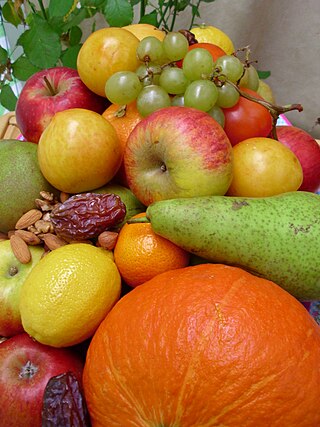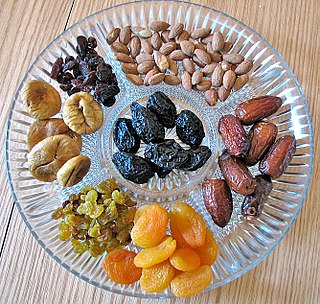Related Research Articles

Food is any substance consumed by an organism for nutritional support. Food is usually of plant, animal, or fungal origin and contains essential nutrients such as carbohydrates, fats, proteins, vitamins, or minerals. The substance is ingested by an organism and assimilated by the organism's cells to provide energy, maintain life, or stimulate growth. Different species of animals have different feeding behaviours that satisfy the needs of their metabolisms and have evolved to fill a specific ecological niche within specific geographical contexts.

Fruitarianism is a diet that consists primarily of consuming fruits and possibly nuts and seeds, but without any animal products. Fruitarian diets are subject to criticism and health concerns.

A sugar substitute is a food additive that provides a sweetness like that of sugar while containing significantly less food energy than sugar-based sweeteners, making it a zero-calorie or low-calorie sweetener. Artificial sweeteners may be derived through manufacturing of plant extracts or processed by chemical synthesis. Sugar substitute products are commercially available in various forms, such as small pills, powders, and packets.

A food pyramid is a representation of the optimal number of servings to be eaten each day from each of the basic food groups. The first pyramid was published in Sweden in 1974. The 1992 pyramid introduced by the United States Department of Agriculture (USDA) was called the "Food Guide Pyramid" or "Eating Right Pyramid". It was updated in 2005 to "MyPyramid", and then it was replaced by "MyPlate" in 2011.

Muesli is a cold Swiss breakfast dish, the primary ingredient of which is rolled oats. Traditionally, it is set to soak in water overnight and eaten the next morning with fresh fruit, nuts, lemon juice, and cream sweetened with honey. Additional ingredients, such as other grains, seeds, and dried fruits are sometimes added, and other citrus juice may be used. Yogurt, milk or other milk products, or milk substitutes are now commonly added to both homemade and commercially packaged muesli recipes.

Olestra is a fat substitute food additive that adds no metabolizable calories to products. It has been used in the preparation of otherwise high-fat foods, thereby lowering or eliminating their fat content.

Dried fruit is fruit from which the majority of the original water content has been removed prior to cooking or being eaten on its own. either naturally, Drying may occur by sun, through the use of industrial dehydrators, or by freeze drying. Dried fruit has a long tradition of use dating to the fourth millennium BC in Mesopotamia, and is valued for its sweet taste, nutritional content, and long shelf life.

Food processing is the transformation of agricultural products into food, or of one form of food into other forms. Food processing takes many forms, from grinding grain into raw flour, home cooking, and complex industrial methods used in the making of convenience foods. Some food processing methods play important roles in reducing food waste and improving food preservation, thus reducing the total environmental impact of agriculture and improving food security.

Raw foodism, also known as rawism or a raw food diet, is the dietary practice of eating only or mostly food that is uncooked and unprocessed. Depending on the philosophy, or type of lifestyle and results desired, raw food diets may include a selection of fruits, vegetables, nuts, seeds, eggs, fish, meat, and dairy products. The diet may also include simply processed foods, such as various types of sprouted seeds, cheese, and fermented foods such as yogurts, kefir, kombucha, or sauerkraut, but generally not foods that have been pasteurized, homogenized, or produced with the use of synthetic pesticides, fertilizers, solvents, and food additives.

Baby food is any soft, easily consumed food other than breastmilk or infant formula that is made specifically for human babies between six months and two years old. The food comes in many varieties and flavors that are purchased ready-made from producers, or it may be table food eaten by the family that has been mashed or otherwise broken down.

A healthy diet is a diet that maintains or improves overall health. A healthy diet provides the body with essential nutrition: fluid, macronutrients such as protein, micronutrients such as vitamins, and adequate fibre and food energy.

Canada's Food Guide is a nutrition guide produced by Health Canada. In 2007, it was reported to be the second most requested Canadian government publication, behind the Income Tax Forms. The Health Canada website states: "Food guides are basic education tools that are designed to help people follow a healthy diet."
A diabetic diet is a diet that is used by people with diabetes mellitus or high blood sugar to minimize symptoms and dangerous complications of long-term elevations in blood sugar.

Juice is a drink made from the extraction or pressing of the natural liquid contained in fruit and vegetables. It can also refer to liquids that are flavored with concentrate or other biological food sources, such as meat or seafood, such as clam juice. Juice is commonly consumed as a beverage or used as an ingredient or flavoring in foods or other beverages, such as smoothies. Juice emerged as a popular beverage choice after the development of pasteurization methods enabled its preservation without using fermentation. The largest fruit juice consumers are New Zealand and Colombia. Fruit juice consumption on average increases with a country's income level.
Ch'ang Ming is a series of dietary and health recommendations based on Taoist philosophy. It was first introduced to the West by Chan Kam Lee, a Taoist teacher and Chinese herbal medicine practitioner who came to London in 1930 from Shandong Province in China. He took the Taoist principles of Traditional Chinese Medicine and adapted them to Western foods and eating habits.

Clean eating is a fad diet based on the belief that consuming whole foods and avoiding convenience food and other processed foods offers certain health benefits. Variations of the diet may also exclude gluten, grains, and/or dairy products and advocate the consumption of raw food. Extreme versions of the diet have been criticized for lacking scientific evidence and potentially posing health risks.
Toddler nutrition is the description of the dietary needs of toddlers aged one to two years old. Food provides the energy and nutrients that toddlers need to be healthy. An adequate intake in nutrient rich food is good nutrition. A diet lacking essential calories, minerals, fluid and vitamins could be considered 'bad' nutrition. Nutrition needs are different for toddlers. For a baby, breast milk is "best" and it has all the necessary vitamins and minerals. Toddlers typically have been weaned from breast milk and infant formula. Though infants usually start eating solid foods between 4 and 6 months of age, more and more solid foods are consumed by a growing toddler. If a food introduced one at a time, a potential allergen can be identified. Food provides the energy and nutrients that young children need to be healthy. Toddlers are learning to feed themselves and to eat new foods. They should eat a variety of foods from all the food groups. Each day, toddlers need enough nutrients, including

Carlson Wade was an American alternative health writer who authored many books promoting detoxification, fasting, juicing, megavitamin therapy, natural foods and raw food dieting. He developed a fad diet known as the Enzyme-Catalyst Diet.

The Atlantic diet refers the traditional eating habits of people in northwestern Spain and Portugal, and focuses on unprocessed foods, vegetables and fruits, nuts, whole grain bread, fish, dairy, eggs, some red meat and wine. As both emphasize avoiding processed foods, the Atlantic diet is similar to the Mediterranean diet. The Atlantic diet involves more fish, milk, potatoes, bread, red meat and pork, while the Mediterranean diet has more pasta, beans and seeds, and greater emphasis on healthy fat from extra-virgin olive oil rather than fatty fish like mackerel, sardines and salmon.
References
- 1 2 Mackey, John; Pulde, Alona; Lederman, Matthew (2017-04-11). The Whole Foods Diet: The Lifesaving Plan for Health and Longevity. Grand Central Publishing. ISBN 978-1-4789-4489-8.
- 1 2 Bliss, Nishanga (2012-04-01). Real Food All Year: Eating Seasonal Whole Foods for Optimal Health and All-Day Energy. New Harbinger Publications. ISBN 978-1-60882-157-0.
- 1 2 "Whole Foods - NYC Health". www.nyc.gov. Retrieved 2024-09-07.
- ↑ "What are whole foods?". www.bhf.org.uk. Retrieved 2024-09-07.
- ↑ Wood, Rebecca (2010-04-27). The New Whole Foods Encyclopedia: A Comprehensive Resource for Healthy Eating. Penguin Publishing Group. ISBN 978-0-14-311743-8.
- ↑ "What Is a Whole-Foods Diet? Benefits, Risks, Food List, and More". EverydayHealth.com. 2024-08-28. Retrieved 2024-09-07.
- ↑ "Clean-Eating Foods List". EatingWell. Retrieved 2024-09-07.
- ↑ Program, Human Foods (2024-09-03). "Use of the Term Natural on Food Labeling". FDA.
- ↑ Katz, D. L.; Meller, S. (2014). "Can we say what diet is best for health?". Annual Review of Public Health. 35: 83–103. doi:10.1146/annurev-publhealth-032013-182351. ISSN 1545-2093. PMID 24641555.
- 1 2 3 4 "What are whole foods?". www.bhf.org.uk. Retrieved 2024-09-07.